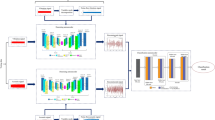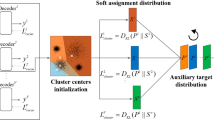Abstract
The traditional singular value decomposition (SVD) method is unable to diagnose the weak fault feature of bearings effectively, which means, it is difficult to retain the effective singular components (SCs). Therefore, a new singular value decomposition method, SVD based on the FIC (fault information content), is proposed, which takes the amplitude characteristics of fault feature frequency as the selection index FIC of singular components. Firstly, the Hankel matrix of the original signal is constructed, and SVD is applied in the matrix. Secondly, the proposed index FIC is used to evaluate the information of the decomposed SCs. Finally, the SCs with fault information are selected and added to obtain the denoised signal. The results of bearing fault simulation signals and experimental signals show that compared with the traditional differential singular value decomposition (DS-SVD), the proposed method can select the singular components with larger amount of fault information and is able to diagnose the fault under the heavy noise interference. The new method can be used for signal denoising and weak fault feature extraction.

















Similar content being viewed by others
Availability of data and material
The data used in this paper are all owned by the lab of the research group. As the research is still continuing, the data involved in this paper is not publicly available.
Code availability
The algorithm involved in this paper is still being studied by the research group, so it is not publicly disclosed.
References
Tandon N, Choudhury A (1999) A review of vibration and acoustic measurement methods for the detection of defects in rolling element bearings [J]. Tribol Int 32:469–480
Yuanxing L (2014) Analysis on the repair of rolling bearings[J]. Heilongjiang Science 7:248–248
Cui L, Sun Y, Wang X, Wang H (2021) Spectrum-based, full-band preprocessing, and two-dimensional separation of bearing and gear compound faults diagnosis. IEEE Trans Instrum Meas 70:3513216
Wang X, Cui L, Wang H, Jiang H (2021) A generalized health indicator for performance degradation assessment of rolling element bearings based on graph spectrum reconstruction and spectrum characterization. Measurement 176:109165
Cheng Q, Qi B, Liu Z, Zhang C, Xue D (2019) An accuracy degradation analysis of ball screw mechanism considering time-varying motion and loading working conditions [J]. Mech Mach Theory 134:1–23
Zhang Z, Cheng Q, Qi B, Tao Z (2021) A general approach for the machining quality evaluation of S-shaped specimen based on POS-SQP algorithm and Monte Carlo method [J]. J Manuf Syst 60:553–568
Niu P, Cheng Q, Liu Z, Chu H (2021) A machining accuracy improvement approach for a horizontal machining center based on analysis of geometric error characteristics [J]. Int J Adv Manuf Technol 112(9–10):2873–2887
Li C, Ruojun Z (2017) Research on fault diagnosis of fan bearing based on acoustic emission[J]. Instrument Technology and Sensor 09:109–113
Golafshan R, Yuce Sanliturk K (2016) SVD and Hankel matrix based de-noising approach for ball bearing fault detection and its assessment using artificial faults. Mech Syst Signal Process. 70–71:36–50
Yang WX, Tse PW (2003) Development of an advanced noise reduction method for vibration analysis based on singular value decomposition. NDT&E International 36(6):419–432
Zhao M, Jia X (2017) A novel strategy for signal denoising using reweighted SVD and its applications to weak fault feature enhancement of rotating machinery. Mech Syst Sig Process 94:129–147
Zhang YX, Wang XL, Zhang SH et al (2014) Rolling element bearing fault diagnosis based on singular value decomposition and correlated kurtosis. J Vib Shock 33(11):167–171
Borghesani P, Pennacchi P, Chatterton S (2014) The relationship between kurtosis- and envelope-based indexes for the diagnostic of rolling element bearings. Mech Syst Signal Process 43:25–43
Lei Y, He Z, Zi Y (2011) EEMD method and WNN for fault diagnosis of locomotive roller bearings. Expert Syst Appl 38:7334–7341
Lin J, Qu L (2000) Feature extraction based on Morlet wavelet and its application for mechanical diagnosis. J Sound Vib 234:135–148
Tse PW, Wang D (2013) The design of a new sparsogram for fast bearing fault diagnosis: part 1 of the two related manuscripts that have a joint title as “Two automatic vibration-based fault diagnostic methods using the novel sparsity measurement—Parts 1 and 2.” Mech Syst Signal Process 40:499–519
Zonoobi D, Kassim AA, Venkatesh YV (2011) Gini index as sparsity measure for signal reconstruction from compressive samples. IEEE J Sel Topics Signal Process 5:927–932
Guo M, Li W, Yang Q, Zhao X, Tang Y (2019) Amplitude filtering characteristics of singular value decomposition and its application to fault diagnosis of rotating machinery, Measurement
Acknowledgements
This work is supported by the National Natural Science Foundation of China under Grant No. 52075008. The authors are grateful to the editors and anonymous reviewers for their helpful comments and constructive suggestions.
Funding
This research is funded by the National Natural Science Foundation of China (Grant No. 52075008).
Author information
Authors and Affiliations
Contributions
MXS analyzed the data. LLC and CQZ provided guidance and recommendations for the research. MXS contributed to the contents and writing of the manuscript. All authors have read and approved the final manuscript.
Corresponding author
Ethics declarations
Ethics approval
The team affirmed that all the research was original research of the research group without any bad behavior.
Consent to participate
The methods involved in this paper are agreed to be shared.
Consent for publication
The content of this thesis is agreed to be published in the journal.
Conflict of interest
The authors declare no competing interests.
Additional information
Publisher's note
Springer Nature remains neutral with regard to jurisdictional claims in published maps and institutional affiliations.
Rights and permissions
About this article
Cite this article
Cui, L., Sun, M. & Zha, C. Early bearing fault diagnosis based on the improved singular value decomposition method. Int J Adv Manuf Technol 124, 3899–3910 (2023). https://doi.org/10.1007/s00170-021-08237-2
Received:
Accepted:
Published:
Issue Date:
DOI: https://doi.org/10.1007/s00170-021-08237-2




